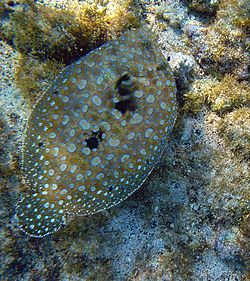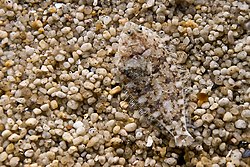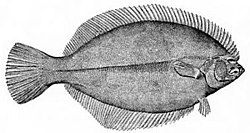Flounder
Flounders are a group of flatfish. The term is used for a number of flatfish who only related by being in the suborder Pleuronectoidei: (families Achiropsettidae, Bothidae, Pleuronectidae, Paralichthyidae, and Samaridae). It is a "form name", which means they are not necessarily close relations, they just look alike.
Flounders live at the bottom of coastal lagoons and estuaries of the Northern Atlantic and Pacific Oceans. When flounder are hatched they have one eye on each side of its head. As they grow one eye moves until they have both eyes on the same side of the head.
Industrial overfishing has reduced the population to one-tenth of its original size, and the individuals left are smaller. They rarely have the time to grow to full size.[1][2][3][4]
Habitat
Flounder feed at soft muddy areas of the sea bottom, near bridge piles, docks and coral reefs. They have been found at the bottom of the Mariana trench, the deepest known ocean canyon. Swiss scientist Jacques Piccard and US Navy Lt. Don Walsh reached a depth of 10,916 meters (35,814 ft). They were surprised to discover flounder about 30 cm long.
A flounder's food is mainly fish spawn, crustaceans, polychaetes and small fish. Flounder normally grow to a length of 12.5–37.5 centimeters (4.9–14.8 in), and as large as 60 centimeters (24 in). Their width is about half their length.
Camouflage
Flounders are highly camouflaged, often more so than these examples. But they are fished by bottom trawls which scrape them off the sea-bed into the net.
Taxonomy
Flounder is a general term for many species.
- Western Atlantic
- Gulf Flounder - Paralichthys albigutta
- Southern flounder - Paralichthys lethostigma
- Summer flounder (also known as fluke) - Paralichthys dentatus
- Winter flounder - Pseudopleuronectes americanus
- European waters
- European flounder - Platichthys flesus
- Northwestern Pacific
- Olive flounder - Paralichthys olivaceus
Flounder Media
Winter flounder, Pseudopleuronectes americanus
References
- ↑ Clover, Charles (2008). The end of the line: how overfishing is changing the world and what we eat. University of California Press. ISBN 978-0-520-25505-0. OCLC 67383509.
- ↑ Myers, R.A.; Worm, B. (2003). "Rapid worldwide depletion of predatory fish communities". Nature. 423 (6937): 280–283. Bibcode:2003Natur.423..280M. doi:10.1038/nature01610. PMID 12748640. S2CID 2392394.
- ↑ Dalton, Rex (2006). "Save the big fish: targeting of larger fish makes populations prone to collapse". BioEd Online. Archived from the original on 27 March 2017. Retrieved 26 March 2017.
- ↑ Hsieh, Chih-hao; Reiss, Christian S.; Hunter, John R.; Beddington, John R.; May, Robert M.; Sugihara, George (2006). "Fishing elevates variability in the abundance of exploited species". Nature. 443 (7113): 859–62. Bibcode:2006Natur.443..859H. doi:10.1038/nature05232. PMID 17051218. S2CID 4398663.



